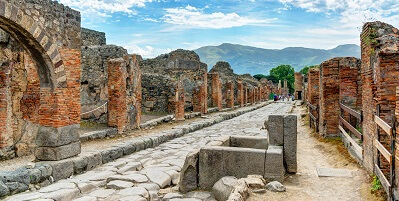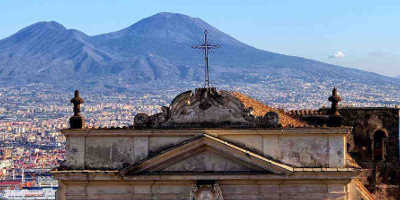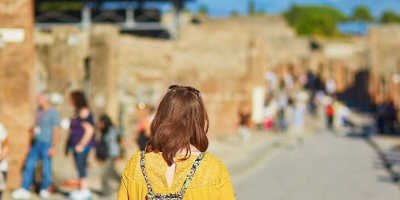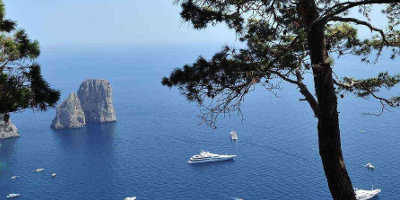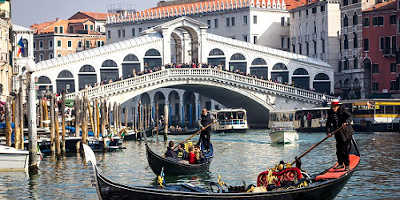How long was Pompeii buried before it was uncovered?
Destroyed in 79 AD by Mount Vesuvius’s eruption, how long was Pompeii left buried before finally being rediscovered?
Pompeii is one of the most popular and largest archaeological tourist spots in the entire world. But once, it was a lost city, hidden from the world in a natural time capsule.
Pompeii’s End
The once thriving Roman city met its tragic end after Mount Vesuvius’ erupted in 79 BC. Waves of ash and gas destroyed all life within the city, burying the buildings, streets, and people in a thick layer of volcanic debris that solidified into stone. Leaving the once beloved city deep in the ground. Those who did survive left the city and moved to nearby settlements to start their new life, leaving the victims of the volcano to be preserved in the ground. Some came back to the city to loot it, robbing or salvaging any valuables they could find. It is impossible to know who these people were, either people who had witnessed or heard of the eruption from afar and chose to rob the remains, or perhaps survivors of Pompeii who came back to claim their belongings. Either way, it is clear that things were taken, from marble statues to building materials. You might be wondering how this was possible if the city laid buried in metres of volcanic ash and debris. Well, according to archaeologists, the tops of buildings would still have been visible following the tragedy, acting as indications for whoever showed up. Apart from recent years or months following the city’s destruction, the city was left forgotten for many centuries. Years and years past, and Pompeii became a distant memory before vanishing from history altogether.
The Hidden Years
The city was hidden from the world for decades, completely sealed off from human intervention. Its initial discovery was in 1599 when the architect Domenico Fontana was constructing an underground channel to divert the river Sarno. The construction project unearthed a number of frescoes, inscriptions, and architectural blocks while digging a canal. After the architect unearthed a few more erotic frescoes, he then covered them up again. It’s not clear how accurate these accounts are, but people believed he covered these up because they were too sexually explicit for the time. To think this may have happened is shocking! And once again the city was left and forgotten. Another hundred years passed following this first secret finding with the next rediscovery not occurring until the eighteenth century. Further incidental detections began in the early 1700s after workers building a summer palace for the King of Naples discover part of the ruins. Prompting a large investigation and evacuation. Royals began plundering the area for ancient decorations worthy for their palaces. And it was not until the 1800s that archaeologists started studying the area appropriately, beginning the longest continually excavated site ever seen.
Ongoing Excavations
A large proportion of Pompeii was excavated during the 19th century onwards under the guidance of Giuseppe Fiorelli, an Italian archaeologist who is responsible for the plaster casts, something still used today. This technique involves pouring plaster into the cavities left by the voids in the decayed corpses to preserve the bodies left behind by the eruption and stop them decaying. Working with the casts was no doubt a moving project, as I’m sure it still is today. Bodies hardened and encased in the same places in which they fell, it’s like working with real patients. This was not the only thing Fiorelli did, he also introduced the site’s current divisions. He organised the excavations into different regions across the archaeological site, ensuring a more safe and methodical way of discovering the city’s ruins. Since Fiorelli, there have been a number of leading archaeologists exploring the site who have stayed in keeping with his ideas and careful considerations. Today, whole teams of experts carefully uncover, process and analyse Pompeii’s findings taking extra care to preserve the site. Now exposed to the elements there are worries around how well the antiquity of the site will last. Though hidden before, it was at least safe and protected, and now it will never be the same.
What you can see at Pompeii today?
A third of the city is still buried, with the exposed sections open for tourists to venture into. The site draws thousands of travellers from around the world annually, offering visitors a chance to step back in time to the ancient world of Pompeii. Stroll through the cobblestoned streets and marvel at the historic buildings, artefacts, and human remains hidden within. Learn about the past everyday lives of the people of Pompeii, seeing the differences and similarities to modern-day. Regardless of whether you are a history buff or simply following the crowds, you will certainly not be disappointed in the city of Pompeii.

